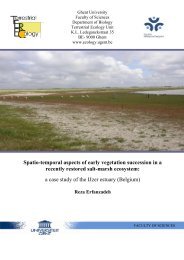PhD Arthur Decae 2010 - Ghent Ecology - Universiteit Gent
PhD Arthur Decae 2010 - Ghent Ecology - Universiteit Gent
PhD Arthur Decae 2010 - Ghent Ecology - Universiteit Gent
Create successful ePaper yourself
Turn your PDF publications into a flip-book with our unique Google optimized e-Paper software.
(Coddington 2005) and therefore lags behind other developments in biological knowledge.<br />
The rewards of studying mygalomorphs however will be in keeping with the efforts and a<br />
much improved vista on the evolutionary history of a major animal group can thus be<br />
obtained.<br />
Outline and objectives<br />
The Mediterranean mygalomorph fauna, as it is presently known, contains representatives of<br />
seven different spider families, eleven genera and approximately 120 species (see Chapter 8<br />
general conclusions). Current knowledge of Mediterranean Mygalomorphae largely rests on<br />
old and often incoherent information that has accumulated over the past 200 years. However<br />
all families and genera need thorough taxonomical revision before deeper biological insight<br />
can be developed. This elementary though necessary work is beyond the scope of this thesis.<br />
However two genera − Ummidia Thorell 1875 and Cyrtocarenum Ausserer 1871 − have been<br />
fully revised on all material available (Chapters 6 & 7) and the complex and diverse genus<br />
Nemesia Audouin 1826 has been revised for local geographic regions (the Balearic Islands in<br />
Chapter 2 and Portugal in Chapter 3). To structure future research on the Mediterranean<br />
Nemesiidae a genus level revision was carried out (Chapter 4) resulting in the splitting-off of<br />
a new genus (Iberesia <strong>Decae</strong> & Cardoso 2005) from traditional Nemesia stock, and the<br />
establishment of two subgenera (Pronemesia and Holonemesia) within Nemesia (Chapter 5).<br />
Within both Pronemesia and Holonemesia several distinct species-groups are recognized and<br />
discussed (Chapter 5). Work on the remaining mygalomorph genera occurring in the<br />
Mediterranean Region −Atypus, Brachythele, Chaetopelma, Cteniza, Cyrtauchenius,<br />
Ischnocolus, Macrothele and Idops− is restricted to descriptions of their species diversity and<br />
Mediterranean distributions. The probable regions of origin for all these genera and their<br />
affinities to related genera outside the Mediterranean are discussed in Chapter 8.<br />
The central object of study is the Mediterranean mygalomorph spider fauna. To provide an<br />
informative backdrop for understanding the arachnological information contained in this work<br />
the history and biological importance of the Mediterranean Region as an area of high<br />
biodiversity will be described below separate from an exposé on mygalomorph spiders. The<br />
general background information on Mygalomorphae and their presumed sister-group the<br />
Liphistiomorphae is intended to shed a new and original light on spider phylogeny and spider<br />
evolution that departs from conventional arachnological views.<br />
The Mediterranean Region<br />
Why study the Mediterranean<br />
Obviously there are many very good answers to this question depending on whatever your<br />
line of interest is. One very good reason is that, for people, the Mediterranean is a very<br />
pleasant place to be. This is not only evidenced by the huge success of modern mass tourism<br />
in the region, it is also evidenced by early Homo erectus visitors coming straight from Africa.<br />
H. erectus settled in the Mediterranean at least half a million years ago (Dennel & Roebroeks<br />
1994, Turner 1999) and since that early period mankind has never left the beautiful places that<br />
surround the bluest of all seas. Within the Mediterranean Region humans developed their<br />
incredible success as a biological species. They started off as small tribes equipped with<br />
stones and sticks looking for whatever nature would provide, but in the benign environment of<br />
the Mediterranean they became farmers, citizens, soldiers, empire builders, discoverers of the<br />
world and of the universe. For the rise of human civilization the Mediterranean certainly is a<br />
‘hotspot’.










